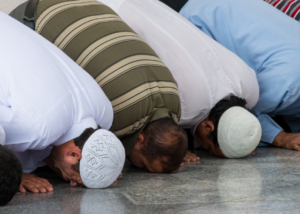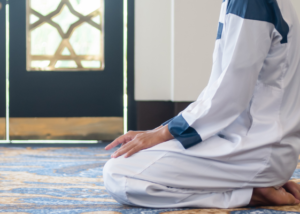Quran
Hadith
Islamic Text
بِسْمِ اللَّهِ الرَّحْمَنِ الرَّحِيمِ
In the Name of Allah Most Merciful Most Kind
Praise be to Allah, and His Salutations and Peace be upon our Master Muhammad ﷺ, his believers and Companions.
Quran
Allah, Exalted is He, states in the Qur’an:
وَمَا جَعَلَ عَلَيْكُمْ فِي الدِّينِ مِنْ حَرَجٍ
“and He has not made any difficulty upon you in the religion” – al-Hajj:78
A similar question
My noble teacher, Shaykh Salim al-Khatib, Allah preserve him, has written an answer on on a similar question related to this matter.
He has written as to when it is permitted to pray on a chair which is as follows:
1, Praying on a chair follows the same rules as one who is praying whilst sitting on the ground; therefore, it is permitted to pray on a chair in two scenarios:
-
- Inability to pray standing for an obligatory prayer.
- A voluntary prayer, even Eid Prayer or Eclipse Prayer etc, although one has the ability to pray standing. However, they will be subject to half the reward of the one who prays standing.
2, Praying on a chair, according to what this poor servant has arrived to, has the following details:
-
- If the person is unable to perform the prostration (sujūd) if they were to pray sitting on the ground, such as having back problems for example, but if they were to pray on a chair, they would be able to pray standing and perform the bowing (rukū’) from standing. Such a person would be obliged to pray whilst sitting on a chair.
- If the person would be able to prostrate on the ground with their forehead if they were to pray whilst sitting on the ground, but if they were to sit on a chair, they would not be able to pray standing during the recitation of Qur’an nor bow. This person would be obliged to pray whilst sitting on the ground, not on a chair, unless sitting on the ground will bring about severe hardship to the individual.
- If the person would be able to prostrate on the ground, whilst sitting on the ground in prayer, but they would not be able to pray standing nor bow from standing, but if they were to pray sitting on a chair, they would be able to pray standing and bow from standing but not be able to prostrate on the ground.For this person, it has been said that they are to pray whilst sitting on the ground and they must prostrate on the ground because prostration in prayer cannot be removed – not in obligatory nor voluntary prayers. It has also been said that they are to pray whilst sitting on a chair because in this state they would be able to perform two pillars of the prayer properly whilst standing, recitation [of al-Fatihah] and bowing, as well as standing from bowing, but if they were to pray whilst sitting on the ground, they would only be able to perform the prostration properly.
How should one sit?
By default, the person who prays whilst sitting needs to ensure that their hips are aligned with the row they are praying in, but this is perhaps only the case where this does not cause inconvenience for the people, by taking up too much space – as it would apply to a chair as well.
Therefore, based on the aforementioned according to what this poor servant has arrived to, it is necessary for the person [who is sitting on the chair] to ensure that the back legs/base of the chair are aligned with the row they are praying in and they would be situated in front of the row during the standing and bowing portions of the prayer. This is so as to not cause inconvenience for the people by taking up too much space [for those behind him], and his position ahead of the row would be excused due to the chair.
This, however, would not be the case if the person was praying in the last row or in a place which would not cause inconvenience to the congregation; they would need to ensure that the chair is situated behind the row such that their hips, whilst sitting on the chair, would be aligned with the row.
Two important matters
It is important to bring attention to two matters at this point:
- It can be witnessed in many Muslim countries the common folks’ lack of heed for praying on a chair without considering the parameters set by the Sacred Law. Therefore, it is important for people to be reminded that praying on a chair is not a matter that is down to what the person feels like; rather, it is only if they are unable to pray standing as has already been explained.
- It can also be witnessed in some mosques where chairs have been built into the ground and on certain occasions this can cause inconvenience for the congregation. It could be said that this is prohibited based on what our scholars have mentioned where it is prohibited to build a Qur’an bookstand that is not removable as has been done in the Grand Azhar Mosque. Al-Khatib said this is prohibited without qualifying the statement whilst Ibn Ajar states this is prohibited only if it causes inconvenience to the congregation, even if it is only once. (Mughni’ul-mutaj 3:557, Tuhfat’ul-muhtaj 6:257)
The Arabic text
The Arabic version can be found below:
لعل جوابه إن شاء الله في اﻵتي:
أوﻻ: الصﻻة على الكرسي لها نفس أحكام الصﻻة بالقعود على اﻷرض، فتجوز الصﻻة على الكرسي في حالتين:
1- عند العجز عن القيام في الفريضة
2- في النافلة -ولو الصلاة عيد أو كسوف ونحوهما- مع القدرة على القيام ، لكن بنصف أجر القائم
ثانيا: الذي يظهر للعبد الفقير -بخصوص الصلاة على الكرسي- هذا التفصيل:
1- إذا كان المصلي عاجزا عن السجود -لمرض بظهره مثلا- لو صلى جالسا على اﻷرض، ولكن لو صلى على الكرسي يستطيع بسببه القيام والركوع من قيام فتلزمه الصلاة على الكرسي
2- إذا كان لو صلى على اﻷرض يستطيع السجود -بوضع الجبهة-، ولو صلى على الكرسي ﻻ يستطيع القيام حال القراءة وﻻ الركوع، فيلزمه الصلاة على اﻷرض من دون كرسي، إﻻ إذا كان يلحقه بالصلاة على اﻷرض مشقة شديدة
3- إذا كان لو صلى على اﻷرض يستطيع السجود، دون القيام والركوع من قيام، ولو صلى على الكرسي يستطيع اﻹتيان بالقيام والركوع من قيام وﻻ يستطيع السجود، فقيل: يصلي على اﻷرض ويأتي بالسجود؛ ﻷن السجود ﻻيسقط، ﻻ في الفرض وﻻ في النفل
وقيل: يصلي على الكرسي؛ ﻷنه سيفعل ركنين من قيام ، وهما القراءة والركوع، أي واﻻعتدال، بينما لو صلى على اﻷرض لن يأتي إﻻ بالسجود كامﻻ فقط
ثالثا: اﻷصل لمن صلى جالسا محاذاة الصف بمقعدته، ولكن لعل محله إذا لم يضيق على الناس كما في مسألة الكرسي، وعلى هذا فينبغي على ما يظهر أن يجعل الكرسي محاذيا للصف، ويتقدم المصلي على الصف إذا صلى من قيام حتى ﻻ يؤدي إلى التضييق على المصلين، ويعذر في تقدمه على الصف حينئذ ﻷجل الكرسي.إﻻ إذا كان يصلي في آخر صف، أو في مكان ﻻ يضيق به على أحد، فحينئذ يؤخر الكرسي للخلف ويحاذي الصف بمقعدته.
رابعا: لعله يحسن التنبيه إلى شيئين:
1- يشاهد إسراف العوام في الصلاة على الكرسي في بعض الدول اﻻسلامية من دون الضوابط الشرعية، فينبغي تنبيههم إلى أن اﻷمر ليس بالتشهي، وإنما هو عند العجز عن القيام على ماسبق بيانه.
2- مشاهد في بعض المساجد وضع كراسي ثابتة -ﻻ يمكن تحويلها- وربما يحصل منها تضييق على المصلين في بعض اﻷوقات، ولعل هذا ﻻ يجوز؛ أخذا من قولهم ﻻ يجوز إحداث كرسي مصحف مؤبد يقرأ فيه، كما يفعل بالجامع اﻷزهر.
وقد أطلق عدم الجواز الخطيب، وقيده ابن حجر بما إذا ضيق على المصلين ولو في وقت
(ينظر: مغني المحتاج 3/557، تحفة المحتاج 6/257.)
والله أعلم
Translated by,
Mohammed Jamili
4th Shawwal 1445
Jeddah
And Allah Most High Knows Best.
–Answered by Shaykh Mohammed Jamili (19.04.24)
For related queries concerning the Shafi’i or Hanafi Madhab, refer to the following answers:[1] [2] [3] [4]






